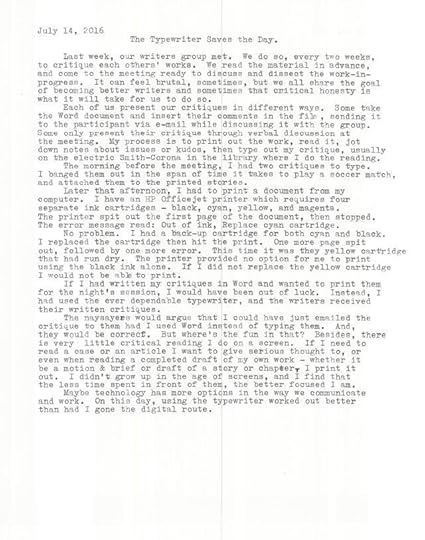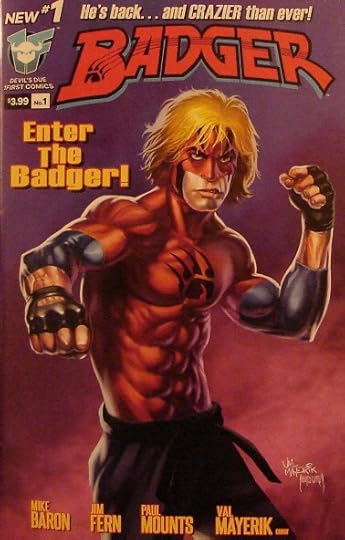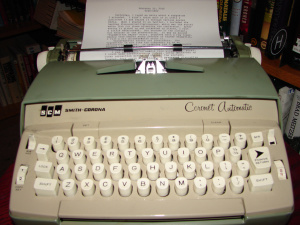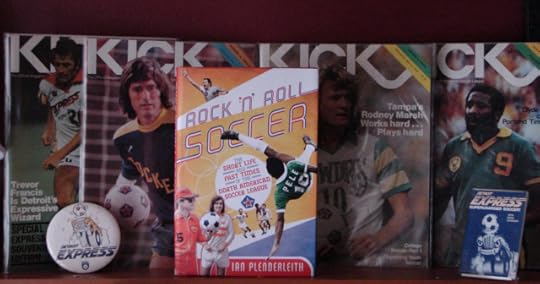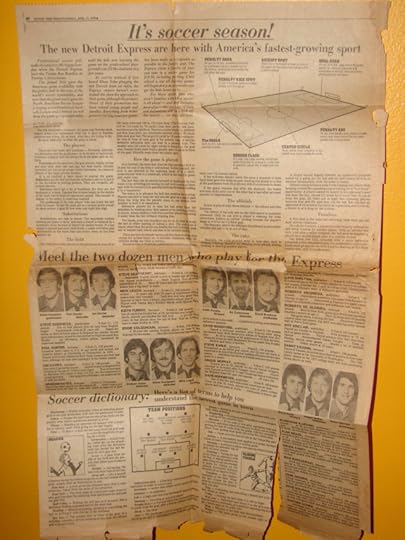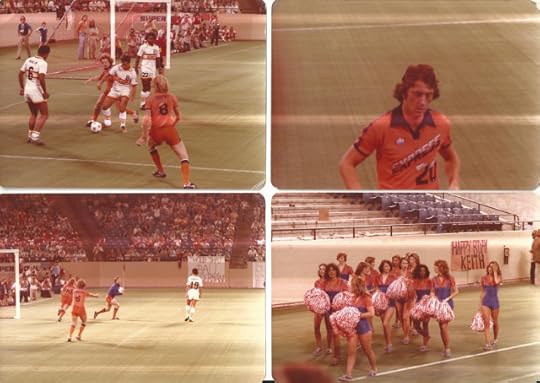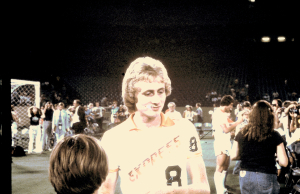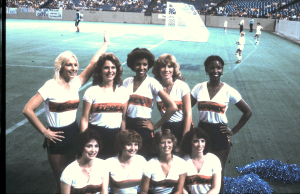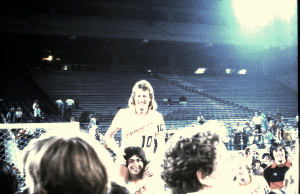Michael Kitchen's Blog, page 16
September 1, 2016
September 1, 2016: So It Begins -SeptNoWriMo

The first four pages, 2,455 words.
Later, I added 213 words, which put me at 2,668 words for the first day. A solid start.
I’m a little concerned, though. I planned out 20 chapters. The writing today put me at the end of Chapter Two. Obviously more fleshing out is going to be necessary as I move forward if I want to achieve 50,000 words at the end of this journey.
There was something else I became suddenly aware of. When I spend an hour or so in front of the computer writing, then walk away to pick up the mail or take the dog out, my eyesight is a little blurry, requiring a few minutes to adjust. After being in front of the typewriter for a period of more than two hours, no eye strain. Walking outdoors to get the mail and take the dog out, my vision was crystal clear.
Better living through typing.
Save
Save
Save
Save
Save
Save
Save


August 19, 2016
Your Heart is a Muscle the Size of a Fist by Sunil Yapa (Literati Cultura)
Once upon a time, I had a favorite book store. It was Borders. From its Novi store opening in the mid-1980’s to its closing in 2011, I spent a lot of time (and money) in that second home.

Since its departure, I’ve explored the indies, and discovered many excellent book stores, each with their unique character. Literati Bookstore is one such treasure.

Located in downtown Ann Arbor, Literati opened in 2013. Fiction on the main floor, nonfiction on lower, the books are displayed on shelves from the old Borders stores. Typewriters shine in the front counter display case, with a manual Olympia on the lower level for patrons to type their thoughts. On the upper floor is a cafe, which was opened recently, where U of M students sit with their laptops and lattes, and author talks and book signings take place.
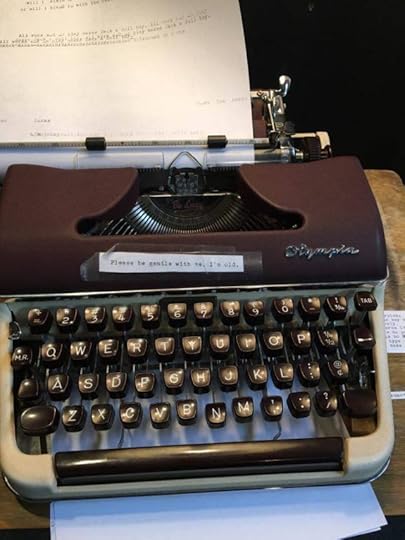
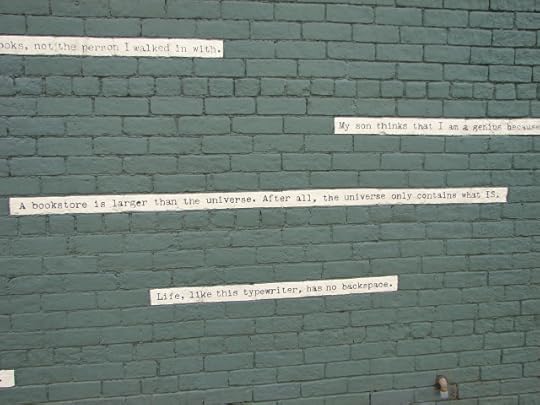 Samples of typed comments adorn the side of Literati Bookstore.
Samples of typed comments adorn the side of Literati Bookstore.In September, 2015, the bookstore started a on-going, signed, first edition, subscription book club called Literati Cultura. Through this, readers enhance their own reading and exploration of new writing. It also allows bibliophiles to grow their libraries with signed first editions, creating a potential collectability element.
Each month, a Literati Cultura subscriber receives a hard cover, first edition book, signed by the author, as selected by owner Hilary Gustafson. Included is a typewritten letter from Ms. Gustafson, detailing why the book was selected, and a limited edition print by Wolverine Press. All this for cost of the hardcover book. If you live a distance from the store – like I do – they will ship it to you for the additional shipping cost. The selections thus far have been:
The Fates and The Furies by Lauren Groff. (Sept. 2015)
Mothers, Tell Your Daughters by Bonnie Jo Campbell (Oct. 2015)
Trace: Memory, History, Race, and the American Landscape by Lauret Savoy (Nov. 2015)
Beloved Dog by Maira Kalman (Dec. 2015)
My Name is Lucy Barton by Elizabeth Strout (Jan. 2016)
Your Heart is a Muscle the Size of a Fist by Sunil Yapa (Feb. 2016)
The Association of Small Bombs by Karan Mahajan (Mar. 2016)
Desert Boys by Chris McCormick (Apr. 2016)
Heat & Light by Jennifer Haigh (May, 2016)
The Girls by Emma Cline (June, 2016)
Miss Jane by Brad Watson (July, 2016)
This month, I’ll be receiving the twelfth book of the subscription – Another Brooklyn by Jacqueline Woodson, completing the first year of the club. I figured it was about time I start getting into these books, as they always seemed to arrive beneath the higher priority books I was reading. Of the eleven titles received thus far, I have only read one. After last night, I can now say I’ve read two.


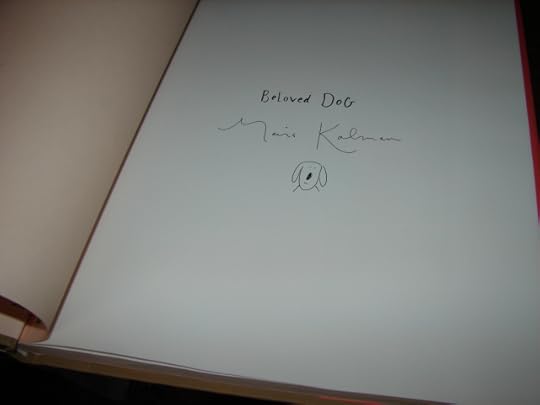
Beloved Dog by Maira Kalman (Dec. 2012 selection) was an easy first book to read. Illustrator, author, and designer, Kalman tells the story of the her life with her husband and the sadness of losing him, and the how the love of a dog – an animal she feared throughout her life – opened her to a new joy for living. It was a quick read as the story is told with words and illustrations, and was approved by my beloved dog, Zen. I gave it the Goodreads rating of a 3 – I liked it.

Of the ten remaining books, the one that jumped out at me first was the February, 2016 selection, Sunil Yapa’s Your Heart is a Muscle the Size of a Fist.
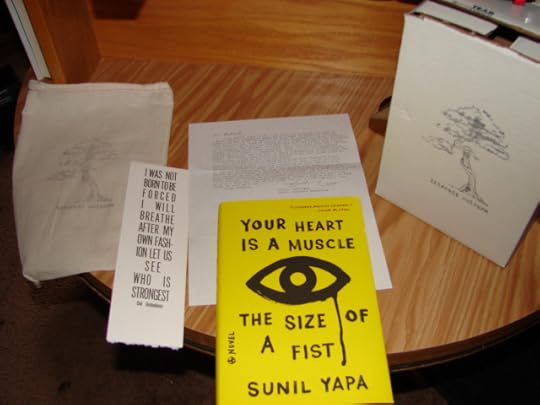
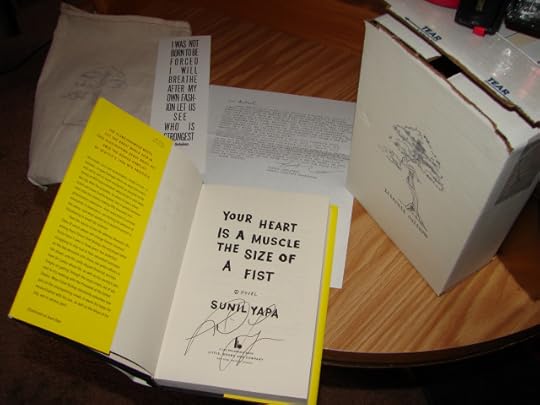
It’s November 30, 1999, as nineteen-year-old Victor emerges from under the bridge of the Seattle freeway he slept beneath, into the organized chaos of ‘N30′ – the first day of the protests against the WTO Ministerial Conference. His step-father, Bishop, is the Chief of Police, and has not seen Victor since the boy left three years earlier to bare witness to the world. The story is told through these two characters, as well as King, a young woman activist with a not-so nonviolent past; King’s lover, John Henry, an older activist from the Vietnam-era; police officers Park and Julia who become engaged with the protestors; and Dr. Charles Wickramsinghe, the diplomat from Sri Lanka seeking to have his country become a member of the WTO.
The novel puts these characters not only into conflict with each other, but within themselves as they confront nonviolent protest, police brutality, and globalization. Yapa does this skillfully, not in a sententious way. The only feeling of stepping out of the novel and into the political came in the way the final chapters were written – from Chapter 40 on. It didn’t bother me as a reader, as it takes its shot at the media and the way such events are covered, but others may have a different opinion of whether it pulled too much away from the characters’ stories.
On the Goodreads scale, I give this book five stars – it was awesome. Some people like to read novels set during periods of war. I enjoy those that are set during occasions of protest.
Save
Save
Save
Save
Save
Save
Save
Save
Save
Save
Save
Save
Save
Save


August 15, 2016
August 15, 2016: SeptNoWriMo
August 5, 2016
Dilly-ding, dilly-dong: The books about Leicester City, professional sports greatest miracle
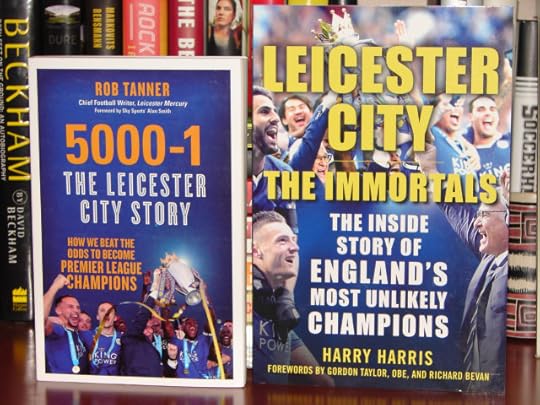
It’s football season. Actually, when is it not football season?
More accurately, it’s almost time for the English Premiere League (EPL) to begin its 2016-17 season. It was the previous year that made sports history, and created a team of immortals.
Prior to the opening of the 2015-16 season, the bookmakers had Leicester (pronounced, ‘Lester’) City Football Club at 5000-1 odds of winning the English Premiere League. To put this in perspective, the 1980 US Olympic Hockey Team had 1000-1 odds of winning the gold medal in what has been called “The Miracle on Ice.” 5000-1 odds are given to events like finding Elvis Presley alive, capturing Bigfoot, and to see the Detroit Lions and Cleveland Browns meet in the 2017 Super Bowl.
The Foxes, as they are known, battled at the end of the previous season to avoid relegation, and fired their manager Nigel Pearson, replacing him with Italian Claudio Ranieri. Ranieri had managed a number of significant European clubs, such as Florentina, Valencia, Chelsea, Juventus, Roma, Inter Milan, and Monaco. In 2014, he was appointed the manager of the Greece National Team, but was discharged after four losing matches, including an embarrassing defeat to the Faroe Islands. Many pundits thought he would be the first manager to be sacked during the season.
The starting players were a band of misfits and castoffs, including:
A keeper, the son of a legendary Manchester United goalkeeper, who was allowed to leave his previous team in a lower league where the coach claimed that he wasn’t good enough,
A player who was surprised when he was sold to Leicester City by his previous team after helping them gain promotion to the Premiere League,
A defender sold by Chelsea, then cast aside by Stoke City.
A player released by the team he had been with since he was eight-years-old,
A player raised by Manchester United, but was loaned out to many clubs until finally sold to Leicester City,
A player who didn’t sign a professional contract until he was 19, having learned his soccer in the streets of Paris, not through an academy,
A player who was told he was too small and not good enough during his developmental years,
And a striker who was released by a club, almost quit soccer completely, and had to fight his way through the non-league ranks, including a spell where he was sentenced to a curfew and wore a tether on his leg. Yet, he would go on to lead the team in goal scoring, and set a league record by scoring a goal in eleven consecutive games.
Leicester City’s entire team payroll would equal the salaries of a handful of players on the elite teams in the league.
Two books have been released in time for the opening kick of the 2016-17 because this team defied the odds, the naysayers, and the world, to become the English Premiere League champions.
5000-1: The Leicester City Story is written by Rob Tanner, the Chief Football Writer of the Leicester Mercury. Tanner has covered the team since 2009, when the Foxes were in League One, the third tier of the English football league system. His proximity makes this a good account of the season, drawing on the events as they happened, with background details about the players and manager. Even though I am an Arsenal fan, I enjoyed reading this. Like so many football fans, Leicester City became my second favorite EPL team. It was hard rooting for them, especially since Arsenal was in the hunt for the championship. But Leicester City lost only three games during the season, and two of them were against the Gunners.
I have not yet read Leicester City The Immortals: The Inside Story of England’s Most Unlikely Champions by Harry Harris. Harris is a British sports journalist and prolific writer of football books, who has culled together a day-by-day diary of the season, combining history, news stories, and tweets of Leicester City’s season. I look forward to reading this book as well.
Leicester City’s miracle provides the cliche’ fictional rags-to-riches sports story, but packs more power, especially if you watched it as it happened. It demonstrated that you don’t have to have the brightest stars or the biggest stadiums to achieve great things. Claudio Ranieri woke up football’s elite with his surprising team and invisible bell.
And Claudio Ranieri is a living example that nice guys do finish first. Tanner quotes Ranieri on the eve of becoming England’s champion,
Once in the life this could happen…that is football…once every 50 years a little team with less money can beat the biggest. Once. Everyone is behind us. There is a good feeling about this story. It is a good story but it is important to finish the story like an American movie, with a happy ending.
On May 1, 2016, Leicester City had the chance to claim the championship at Manchester United with a victory. The Foxes earned a point with a 1-1 draw, forcing Tottenham to win against their London rival, Chelsea, the next night. Tottenham had not won at Stamford Bridge in 26 years, but when Spurs went into the dressing room at halftime with a 2-0 lead, the focus in Leicester City started to sway toward their next home game against Everton.
Then, this happened….
The game progressed, then this happened…
The final minutes couldn’t tick by fast enough for Leicester City fans. When the final whistle blew, the pubs in Leicester City looked liked this…
And the players? The scene at Jamie Vardy’s house…
Just like an American movie, it had a happy ending.
I would definitely recommend Tanner’s book because his perspective is from the inside as the local journalist who has covered the team. Harris’ account looks to be more observational from the outsiders view, thick with detail, including a summary for all 38 games, and team statistics, which appeals to me as well.
Depending on the bookmaker, the odds of Leicester City winning the 2016-17 English Premiere League championship range from 28-1 to 33-1, and anywhere from 66-1 to 100-1 to win the UEFA Champions League.
Save
Save
Save
Save
Save
Save
Save
Save
Save
Save


July 17, 2016
Michigan Street Newspapers.
Homelessness is a massive issue in America. The National Alliance to End Homelessness provides the following snapshot:
In January 2015, 564,708 people were homeless on a given night in the United States.
Of that number, 206,286 were people in families, and
358,422 were individuals.
About 15 percent of the homeless population – 83,170 – are considered “chronically homeless” individuals.
About 2 percent – 13,105 – are considered “chronically homeless” people in families.
About 8 percent of homeless people- 47,725 – are veterans.
There is no single silver bullet to put an end to this problem. But twelve years ago I discovered a resource, for people who enjoy reading, that assists people living without homes.
In 2004, while in the nation’s capital, one of the many homeless people I saw sold me a newspaper. It was called Street Sense, a street newspaper that brings awareness to the community about poverty and homelessness. Seventy-cents of the dollar I paid the vendor went to him. It is one of 112 street newspapers in 35 countries.
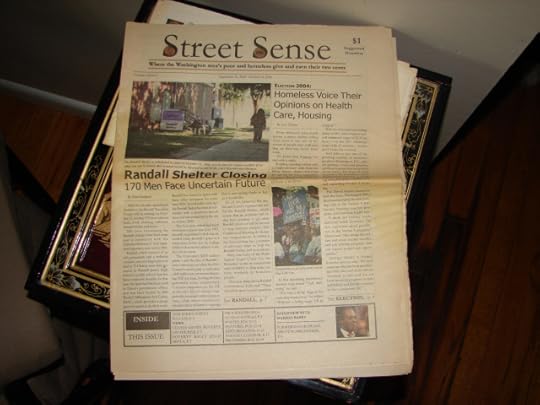
Here in Michigan, there are three such street newspapers.
Groundcover: News and Solutions from the Ground Up is Ann Arbor’s voice for low-income and homeless people. Established in 2010, my introduction to Groundcover came at the 2012 Ann Arbor Art Fair where the organization has a booth in the nonprofits section on Liberty Street. The twelve-page monthly provides a variety of features including topical articles on poverty and homelessness, informational pieces on agencies, health features, book reviews, vendor interviews, and first-person pieces and poetry written by vendors. And, as with the typical daily newspapers, there are coupons, recipes, a comic strip, a crossword puzzle and Sudoku.

In February, I attended a symposium hosted by the Michigan Journal of Race and Law and the University of Michigan Law School titled Innocent until Proven Poor: Fighting the Criminalization of Poverty. The two-day symposium included Vanita Gupta*, Principal Deputy Assistant Attorney General and Head of the Justice Department’s Civil Rights Division as keynote speaker, panel discussions, and workshops covering topics such as Ferguson, MO, policing and regulating the poor, jailing the poor, and others. Susan Beckett, publisher of Groundcover, wrote insightful opinion pieces on the topics of “pay or stay” sentencing (a judge’s order at sentencing for the defendant to pay fines & costs or go to jail), money bail, and indigent defense in the April, May, and June 2016 editions, respectively, based on information presented at the conference.
Usually, you can find vendors selling Groundcover on the streets of downtown Ann Arbor. Except during the Art Fair. During that time, the City of Ann Arbor invalidates their solicitor permits, except for at the Groundcover booth.
 Groundcover vendor Felicia selling July, 2015 issues, which included an interview of her, at the Groundcover booth at the Ann Arbor Art Fair, 2015.
Groundcover vendor Felicia selling July, 2015 issues, which included an interview of her, at the Groundcover booth at the Ann Arbor Art Fair, 2015.In Detroit, Thrive Detroit Street Newspaper: Driving Sufficiency Through Micro-Enterprise is the street paper assisting the city’s low-income and homeless. Founded in 2011, the dollar you pay the vendor puts seventy-five cents into his or her pocket. I spend time downtown at events and such, but I have not yet been approached by a vendor. The only copy I have I found was purchased at Source Booksellers on Cass. But I’ll keep looking for them.
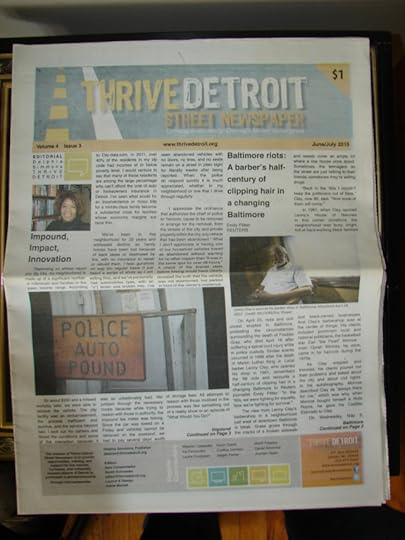
In November, while up in Traverse City for the annual Criminal Defense Attorneys of Michigan conference, I met Steve across the street from one of my favorite hangouts, Horizon Books. He sold me Speak Up Zine: Traverse City’s Voice of People in Transition. Launched in 2014, the 24-page zine is worth the two-dollar donation, with a $1.60 going into Steve’s (or other TC vendors’) pocket. The format is different, and has a more personal approach to it with vendors contributing a lot of the content. Steve was quite proud to show that he was front and center on the cover of this issue.

The skeptics will ask, “How do I know the person is selling me an actual street paper and not something phony just to make a buck?” The street papers enforce a vendor code of conduct which includes such ground rules as not asking for more than the cover price, selling only current issues, and by wearing and displaying a badge while selling the papers. The badge or some form of outward identification is the key. Furthermore, the vendors are not to hard-sell the public, and are not to sell additional products or panhandle while selling the paper.
Poverty and homelessness is a huge issue in this country. The Guilty Until Proven Poor symposium offered a vast amount of information on how our society uses laws and the judicial system to penalize a person for being poor, and a recent panel discussion at Pages Bookshop with contributors to the newly released book, Ending Homelessness: Why We Haven’t, How We Can (Lynne Rienner Publishers, 2016), broadened the discussion. There is not enough space here to tackle the issue, nor is that the purpose of this article. It can be overwhelming in considering which actions we, as individuals, can take. We can volunteer our time and bring community together, like what is done at Cass Park on the 2nd and 4th Sundays of the month. And we can choose not to turn away from a street paper vendor. Approach him or her and buy a paper from them. Not only will you be helping someone, but you’ll also have some thoughtful reading material to enjoy.
*Ms. Gupta’s keynote remarks and other articles based on the symposium can be found in Volume 21, Issue 2, the Spring 2016 issue of Michigan Journal of Race & Law.
Save
Save
Save
Save
Save
Save
Save
Save
Save
Save
Save
Save
Save


July 14, 2016
July 14, 2016: The Typewriter Saves the Day
June 23, 2016
June 23, 2016: National Typewriter Day
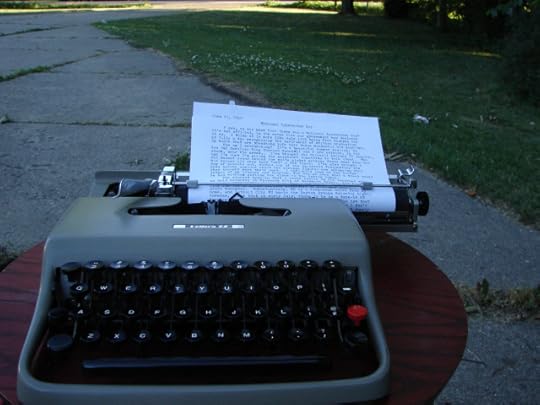
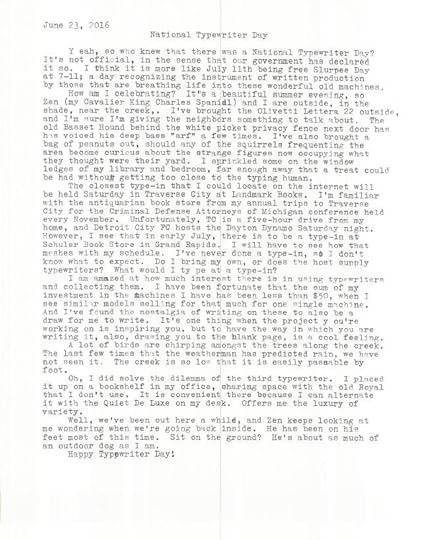
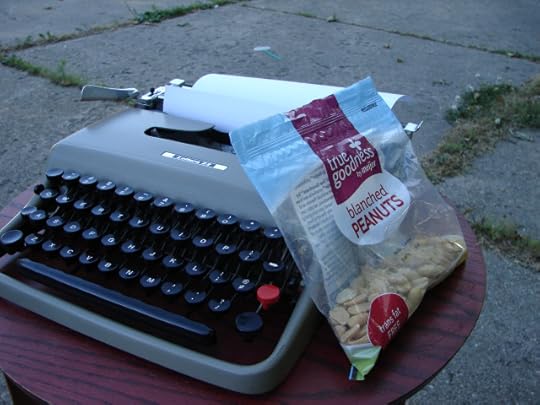 Peanuts for the squirrels.
Peanuts for the squirrels. The creek low on water.
The creek low on water. Zen’s had enough with standing around outdoors. Lay on the ground? Are you nuts, dad?
Zen’s had enough with standing around outdoors. Lay on the ground? Are you nuts, dad?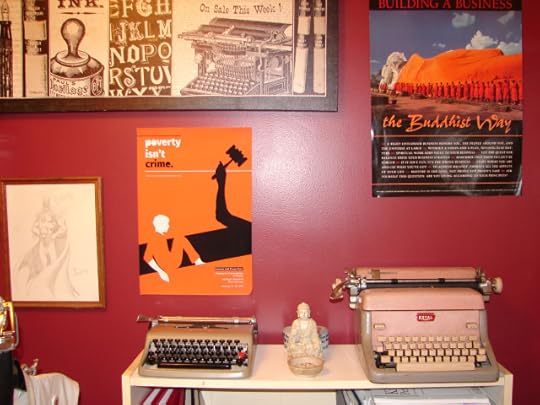 A place for the Olivetti Lettera 22.
A place for the Olivetti Lettera 22.Save
Save


February 24, 2016
Badger #1
Badger #1
Devil’s Due/1First Comics
I was toying around with the idea of a very heavy action strip about an avenger – a vigilante – and I wanted to have a logical foundation for his actions. I thought, “What kind of character puts on a costume and goes out to fight crime on the streets?” And the only thing I could possibly come up with is that you’d have to be stark raving out–of-your-mind to do such a thing. – Mike Baron, Comics Interview #8, Feb. 1984
Batman was the first comic book hero that formed my childhood. But when I went off to college, four titles influenced me the most: Nexus, American Flagg!, The Question, and The Badger.
Both Nexus and The Badger were written by Mike Baron. Where Nexus was the serious science fiction, deeper philosophic title, Badger was a fun romp with psychotic characters.
Norbert Sykes, a Vietnam Veteran, POW, and martial artist, was abused by his step-father resulting in him suffering from multiple personality disorder. One of those personalities is the animal-communing vigilante protecting the streets of Madison, Wisconsin. While admitted to a mental hospital, he is visited telepathically by his neighbor, a John Doe who was found wandering Madison naked and uncommunicative. This John Doe is Ham, a 5th Century Druid who, after being entombed and sent out to sea in 412 AD, wakes up in the 20th Century. Through his telepathic communication with Norbert, Ham learns about the 20th Century from probably not the most reliable source. Still, Ham forms a partnership with the Badger, along with Daisy Fields, their case worker at the hospital who becomes Ham’s personal secretary. She sees Norbert as an interesting case study and person in need of healing (though Ham has use of the the Badger and hopes she does not succeed). Together, they create chaos in dealing with capitalists and demons (at times, kind of hard to tell them apart). His other personalities – inner-city African American Gastinau Grover DePaul, the high-brow Max Swell, nine-year-old Emily, Leroy the dog, and the homicidal Pierre – emerge at the most convenient, and sometimes inconvenient, moments.
The Badger ran from 1983 to 1991, its first four issues with Capital Comics, along with Nexus, and both making the move to First Comics when Capital went under. The character has made a few one-shots and mini-series appearances since, the most recent in 2007 when IDW Publishing collected the first twenty-three issues in four trade paperback collections as well as a graphic novel Badger Saves the World.
Badger #1 (Devil’s Due/1First Comics, 2016) is a re-introduction of the character. Mike Baron brings his creation into the 21st Century with Norbert serving in the fight against Al Qaeda. The personalities are slightly altered – Max Swell now being a gay architect and Emily is a five year old girl.
The tone to this version of Badger is noticeably different. The original series started off with Ham’s story and Badger’s introduction to Ham in the mental hospital, slowly learning more about Norbert as the issues progressed. Here, it’s Norbert’s story with glimpses of his multiple personalities. Though Baron brought Badger and Ham into the 1980’s with a tongue-in-cheek flair, today’s Badger has a serious tone. Baron is sticking with the traditional Badger story line, but the snappy banter is chilled. The prospects of its return appear in the final three pages. Jim Fern’s art serves this mood well, and his single rendering of Ham in the final panel is diabolical.
New readers to the Badger need no knowledge of the past to get into this world. As a long time fan, this issue felt awkward. I found the way the original series slowly revealed Norbert’s backstory as the main story was in action engaging. This issue felt too much like set-up for what’s to come. Getting Norbert from enlistment to mental hospital felt a tad rushed. But it won’t stop me from looking forward to seeing where Baron takes the Badger here in the 21st Century.


February 22, 2016
February 22, 2016: Type-Okay
Rock ‘n’ Roll Soccer: The Short Life and Fast Times of the North American Soccer League by Ian Plenderleith
Rock n Roll Soccer:
The Short Life and Fast Times of the
North American Soccer League
by
Ian Plenderleith
It was April, 1978, when the Detroit Free Press introduced me to Detroit’s new pro team, the Detroit Express of the North American Soccer League (NASL).
I was a hockey fan growing up. But hockey ran from October to May, which then left the summer sport-less. I never got into baseball; the only cool thing about baseball was baseball cards. So, I was intrigued.
WJR-AM covered eighteen of the Express’ games, while WXON-TV 20 broadcast six road games, including the team’s first two matches in Tulsa (2-1 win) and Fort Lauderdale (2-1 OT win). I followed the team via radio, and caught some of the league’s games on ABC. Then, this guy named Trevor Francis came over from the English National Team and the English League’s Birmingham City, and raised the level of excitement. So much so, I finally talked my parents into taking me to the final home game of the season; a 4-2 victory over the Fort Lauderdale Strikers, with Francis scoring two and assisting on another.
It was such a good time we went back nine days later when the Express eliminated the Philadelphia Fury 1-0 in the first round of the playoffs, on a goal by Trevor Francis (who else?)
Ian Plenderleith’s book is not a detailed history of the league, but rather an analysis of its rise and fall, its innovations and dumb ideas, its players and management, and its effect on the game. In today’s game, there are elements that were first introduced in the NASL.
For example, in order to encourage higher scoring, the league awarded the winning team six points, the losing team zero points, but both teams would receive a point for each goal they scored up to three. A winning team could walk away, at most, with nine points, and the losing team could earn up to three. If the match ended in a tie, a fifteen-minute sudden death overtime would be played. If still tied, then a shoot-out would resolve the match. Like the use of penalty kicks today in playoffs or tournaments to resolve a tie, five players on each side would face-off against the keeper in a shoot out. The ball would be placed on the thirty-five yard line. The keeper had no movement restrictions and the shooter had five seconds to move in and shoot on the net. FIFA was using a two-point system for a win, one-point for a draw, with no bonuses for goals scored. Eventually, FIFA moved to a system that awarded three-points for a win, with goal differential deciding ties in the standings.
Other innovations included the thirty-five yard line (then maligned by FIFA who eventually forced NASL to abolish it) to combat the offside rule; three substitutes were allowed in the NASL when the norm was two, which FIFA later adopted; names and numbers on jerseys was only found in the NASL, but is now universal; and targeting women as potential fans was a NASL innovation. The NASL talked about eliminating the time-wasting tactic of the back pass to the goalkeeper, but FIFA wouldn’t consider it until the 1990’s, long after the league’s demise.
Of course, it was the people – players and executives – that made the league memorable. I found the section on Jimmy Hill, a general partner of the Express who was responsible for the arrival of Trevor Francis to Detroit, especially interesting. Stories about Rodney Marsh and George Best, two players who knew how to entertain as well as play the beautiful game; about franchises in Hawaii and Las Vegas which brought interesting challenges; and about the league’s origin being a controversy between two rival leagues in 1967, demonstrated how the NASL planted professional soccer into the American landscape.
An analysis of the NASL would be incomplete without a comparison with America’s current professional league – Major League Soccer (MLS). Even from its outset in 1996 when MLS proclaimed its adamant distinction from the NASL, Plenderlieth draws the similarities and distinction between the two North American leagues.
I found this an enjoyable read broadening what little I had known about the league while following the Detroit Express from 1978 to 1980.




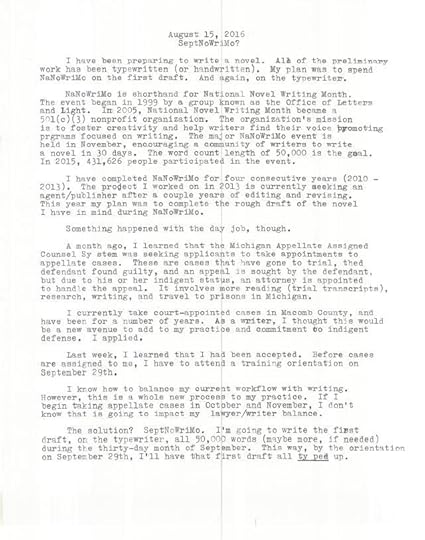
 Writing desk cleared for typewriting during SeptNoWriMo.
Writing desk cleared for typewriting during SeptNoWriMo.

